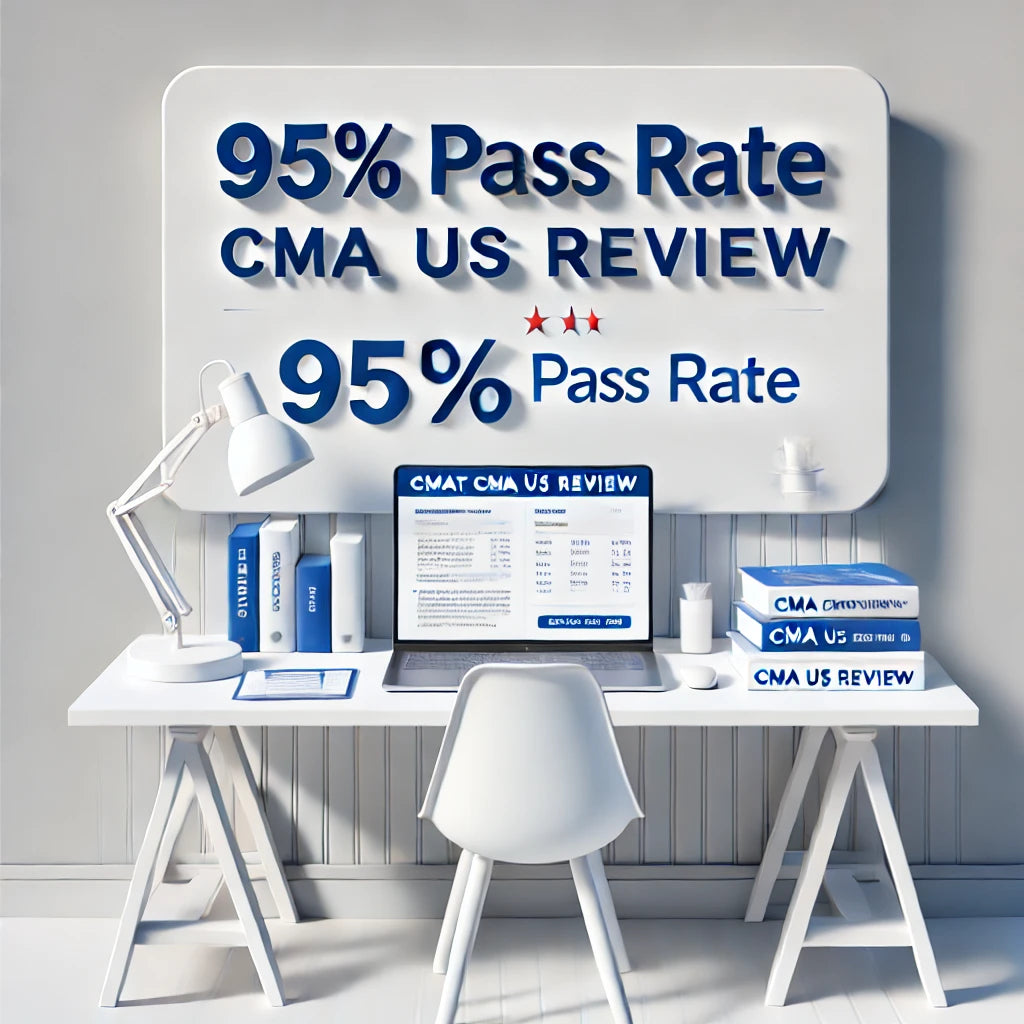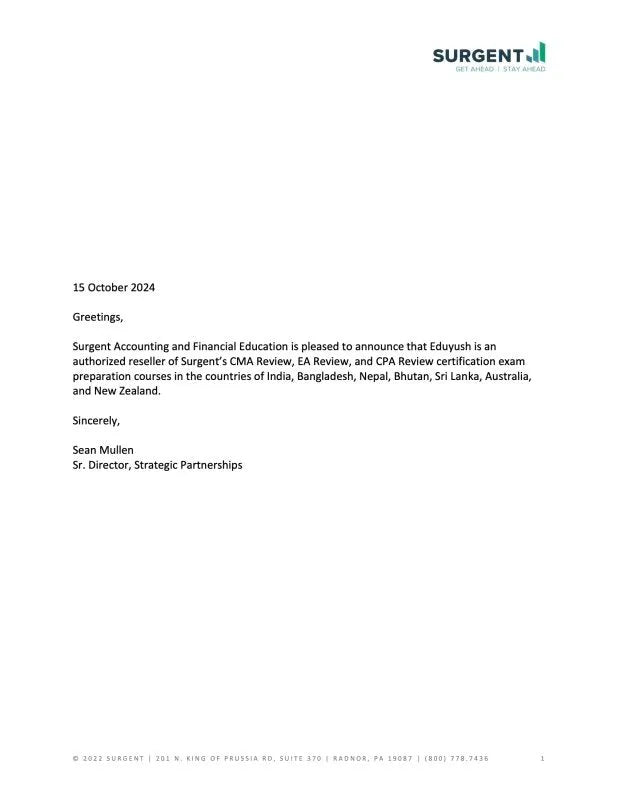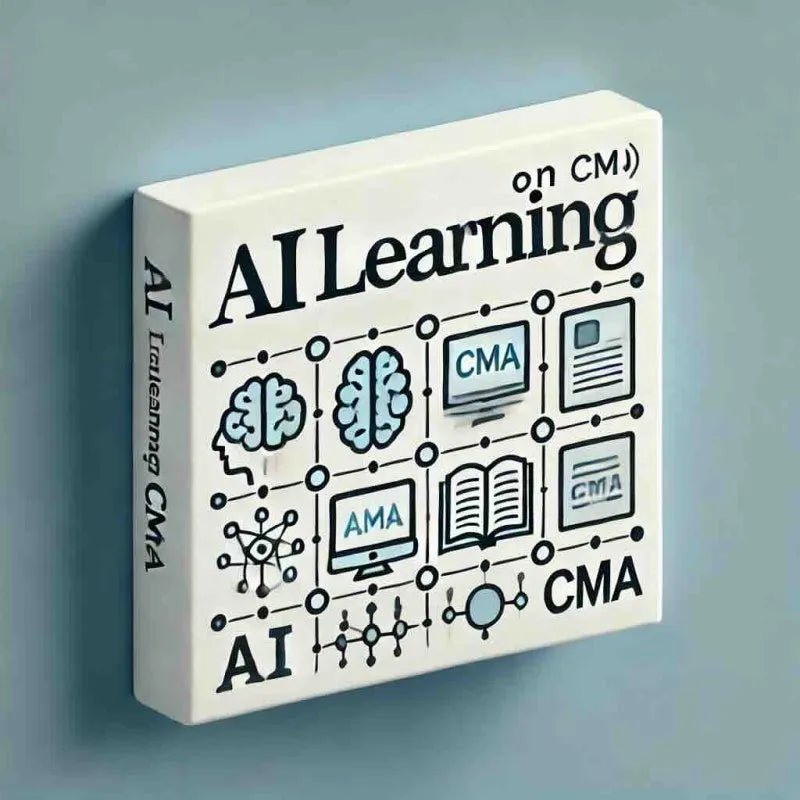CMA Part 1 Formula Sheet
CMA Part 1 Formula Sheet: Essential Formulas for Success
The CMA Part 1 formula sheet is critical for anyone preparing for the Certified Management Accountant (CMA) exam. Understanding and memorizing the most frequently tested formulas can significantly improve your performance. CMA Part 1, covering Financial Planning, Performance, and Analytics, includes various high-yield topics requiring detailed computational knowledge.
This guide’ll break down essential formulas by topic, ensuring you have a comprehensive overview of everything needed to succeed in CMA Part 1.
CMA Part 1 Formulas
External Financial Reporting Decisions (15%)
This section requires a solid understanding of financial statement analysis and accounting fundamentals. Here are some key formulas:
- Current Ratio: Current Assets / Current Liabilities
- Quick Ratio (Acid-Test Ratio): (Current Assets - Inventory) / Current Liabilities
- Gross Profit Margin: Gross Profit / Sales
- Net Profit Margin:
- Return on Assets (ROA): Net Income / Total Assets
- Return on Equity (ROE): Net Income / Shareholders' Equity
-
- Straight-Line Depreciation: (Cost - Salvage Value) / Useful Life
- Double-Declining Balance: Book Value at Beginning of Year × (2 / Useful Life)
- Units of Production Depreciation:(Cost - Salvage Value) / Total Estimated Units × Units Produced
Inventory Valuation
- FIFO (First-In, First-Out): Ending inventory is based on the most recent purchases.
- LIFO (Last-In, First-Out): Ending inventory is based on the oldest purchases.
- Weighted Average Cost:
Planning, Budgeting, and Forecasting (20%)
This section is highly formula-driven, particularly in variance analysis and forecasting.
Key Formulas:
- Sales Price Variance:(Actual Price - Budgeted Price) × Actual Quantity Sold
- Sales Volume Variance:(Actual Quantity Sold - Budgeted Quantity Sold) × Budgeted Price
- Direct Material Price Variance: (Actual Price - Standard Price) × Actual Quantity Purchased
- Direct Material Quantity Variance: (Actual Quantity Used - Standard Quantity Allowed) × Standard Price
- Direct Labor Rate Variance: (Actual Rate - Standard Rate) × Actual Hours Worked
- Direct Labor Efficiency Variance : (Actual Hours Worked - Standard Hours Allowed) × Standard Rate
-
Break-Even Analysis:
- Break-Even Point in Units: Fixed Costs / Contribution Margin per Unit
- Contribution Margin Ratio (CMR): Contribution Margin / Sales Price
Ready to Ace the CMA Exam? Compare the Top 4 CMA USA Courses and Choose the Best Today
Performance Management (20%)
Performance management is another critical component of the CMA Part 1 exam. You must understand formulas for evaluating investment returns, efficiency, and company performance.
Key Formulas:
- Return on Investment (ROI): Operating Income / Average Invested Capital
- Residual Income (RI):Operating Income - (Required Rate of Return × Invested Capital)
- Economic Value Added (EVA): NOPAT - (Capital × WACC)
For more information on calculating ROI and performance metrics, check out how to tackle CMA MCQ questions.
Cost Management (15%)
Cost management in CMA Part 1 often involves calculating and allocating overhead using various costing methods.
Key Formulas:
- Activity-Based Costing (ABC):
- Cost per Activity Driver : Total Cost for the Activity / Total Activity Driver Volume
- Cost Allocated to Product: Activity Rate × Product’s Activity Driver Units
- Job-Order Costing
- Predetermined Overhead Rate : Estimated Total Manufacturing Overhead Costs / Estimated Total Allocation Base (e.g., Direct Labor Hours)
- Applied Overhead: Predetermined Overhead Rate × Actual Allocation Base
- Equivalent Units of Production (Weighted-Average Method): Total Costs (Beginning Inventory + Added Costs) / Equivalent Units
- Cost of Goods Manufactured (COGM): Beginning WIP Inventory + Total Manufacturing Costs - Ending WIP Inventory
Internal Controls (15%)
Although internal controls are more conceptual than computational, it’s essential to understand the principles behind risk mitigation strategies like the COSO Framework. Familiarize yourself with preventive, detective, and corrective controls, and know how these controls protect organizations from risks.
Technology and Analytics (15%)
This section focuses on understanding how technology and analytics influence business decision-making. Although no specific formulas exist, you should be familiar with concepts such as predictive analysis, regression analysis, and data visualization techniques.
How to Use the Formula Sheet Effectively
A formula sheet can be an excellent review tool, but knowing how to apply these formulas during the exam is critical. Here are a few tips:
- Practice Daily: Regularly solve problems involving these formulas to build speed and accuracy.
- Use Flashcards: Create flashcards with formulas on one side and example problems on the other.
- Timed Practice: Work on solving computational problems under timed conditions to simulate the exam environment.
For additional strategies, check out how to tackle essay questions for the CMA exam.
Final Thoughts: Mastering the CMA Part 1 Formula Sheet
To pass CMA Part 1, mastering the essential formulas is non-negotiable. Whether you’re calculating ROI, determining break-even points, or evaluating overhead costs, knowing these formulas will be your key to success. Practice regularly, break down complex questions, and focus on high-yield areas.
For a comprehensive overview of the CMA USA program, check out our detailed guide on CMA USA Course Details.
For more detailed guides on CMA exam topics, visit:
1 comment
Surgent CMA Review course
Pass the CMA USA Exam with a 95% Success Rate
✅Smart, AI-Driven Study Plan for Faster Learning
✅Comprehensive Study Materials & Expert Support
✅Now Available at India pricing at 70% Off
Frequently Asked Questions About the CMA US Certification Course
What is the CMA course, and how does it differ from other accounting certifications?
The CMA US course is a globally recognized certification program for finance and accounting professionals, focusing on strategic financial management, budgeting, and performance management. It’s ideal for those looking to advance in corporate finance roles.
How difficult is the CMA exam, and what are the pass rates?
The CMA exam is known for being challenging, with an average global pass rate of around 45%. The exam consists of two parts: Part 1 focuses on Financial Planning, Performance, and Analytics, while Part 2 covers Strategic Financial Management. Each part has a mix of multiple-choice questions and essay questions, which test both theoretical knowledge and practical application. Most candidates find Part 1 more quantitative and Part 2 more strategic, with both requiring thorough preparation.
How long does it take to complete the CMA US course?
Most candidates complete the course in 6-18 months, depending on study time and preparation. The two exam parts can be scheduled separately, allowing for flexible pacing.
How long do you have to pass both parts?
CMA aspirants have three years to successfully complete both components of the exam from the day they join their program. With ample time available, success is well within reach!
How much time should I dedicate to studying for the CMA exam?
Most candidates report studying between 150 to 200 hours for each part of the CMA exam. If working full-time, this could translate to around 3-5 months per part, depending on your existing accounting knowledge and study habits. A structured study schedule, covering each section systematically and including ample time for practice questions and revision, is essential for success.
CMA resources links
Here are all the links to CMA Resources
- ACCA vs CMA
- CMA Certification
- CMA Exam Centre. Locations
- CMA US online course
- CMA Exam Dates: Complete Guide for your Test in 2025
- CMA Exam Essay Questions: How to Master Them
- CMA Exam fees. Updated for 2024
- CMA Exam High Yield Topics: Where to focus
- CMA Exam Pass Rates: Insights and Tips
- CMA Exam Passing Score: How to Pass with ease
- CMA Exam pattern: Your Complete Guide
- CMA Exam Tips: How to Pass on Your First Try in 2025
- CMA Part 1 Formula Sheet
- CMA Part 1 or Part 2: Which to Take First?
- CMA Performance report: How to Interpret Exam Scores
- CMA Study Plan: How to Master the Exam in 2025
- CMA Syllabus Changes 2025: Key Updates
- CMA US CPE requirements: Complete Guide
- CMA US Eligibility Requirements
- CMA USA Course details: Comprehensive guide
- CMA USA Results: What to Expect in 2025
- CMA vs CA: Which is Better for Your Career?
- CMA vs CPA: Choosing the Right Path for Your Career
- CMA Work Experience Requirement
What are the career prospects for CMA holders, and how does it impact salary?
The CMA credential can open doors to various managerial and executive positions in finance, accounting, and corporate management. Common roles include financial analyst, management accountant, CFO, and financial controller. Salary expectations vary by region, but CMAs generally earn around 30-50% more than their non-certified peers. In the U.S., the average salary for CMAs can range from $80,000 to $150,000 annually, depending on experience and location.
Can I pursue the CMA certification while working full-time?
Yes, many candidates complete the CMA while working full-time. Time management is crucial, and it may involve studying during evenings and weekends. Employers often support CMA candidates by providing study resources, financial assistance, or time off for exam preparation. Reddit users recommend setting realistic goals and maintaining a consistent study routine to balance work and study effectively.
How is the CMA viewed outside the United States?
The CMA is recognized in over 100 countries and is highly regarded in various industries, particularly in regions like the Middle East, China, and India. It is especially valuable for professionals interested in multinational corporations or companies with a global presence. In some countries, CMA-certified professionals may earn equivalent or even higher salaries than CPAs or local accounting professionals.
Is the CMA course worth it if I already have a CPA or another accounting certification?
Many professionals with a CPA or another accounting certification pursue the CMA to gain expertise in management accounting and strategic decision-making. The two credentials can complement each other well, with the CPA focusing more on auditing and tax and the CMA emphasizing corporate finance and strategy. The choice depends on career goals—if you're aiming for managerial roles in corporate finance, the CMA is highly advantageous.
How is the job market for CMAs affected by automation and AI?
While automation and AI have affected traditional accounting roles, they have increased the demand for management accountants who can interpret data and contribute to strategic decision-making. CMAs are well-positioned to leverage these technologies, as their training covers data analytics and performance management, making them valuable assets in organizations seeking to innovate and optimize processes.
What happens if I fail a part of the CMA exam?
If you fail a part of the CMA exam, you can retake it during the next testing window. The IMA offers the exam in three testing windows each year: January-February, May-June, and September-October. Preparing for a retake may involve identifying areas of weakness, revising study materials, and perhaps trying different resources or study methods.
Who is eligible for the CMA US course?
To be eligible, candidates must have a bachelor’s degree from an accredited institution, two years of relevant professional experience in financial or management accounting, and IMA membership.













Hey
Leave a comment